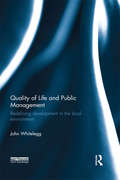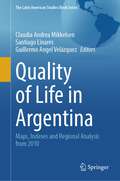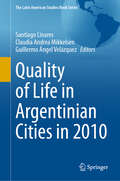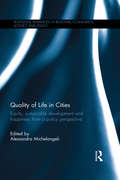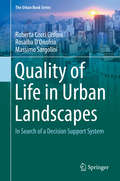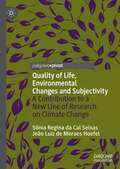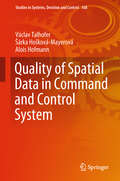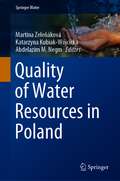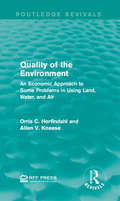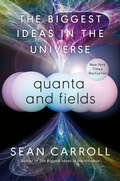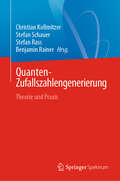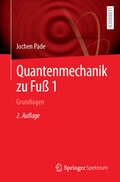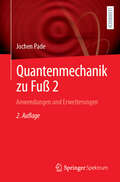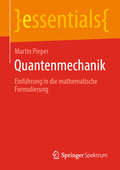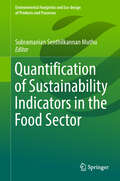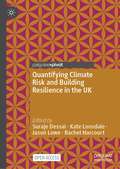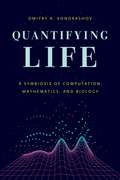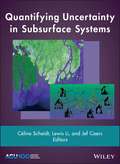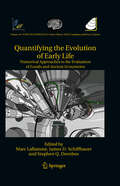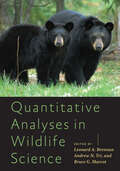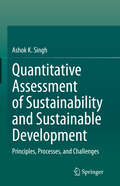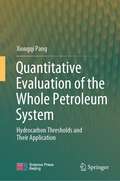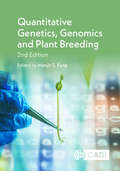- Table View
- List View
Quality and Legitimacy of Global Governance
by Timothy CadmanSince the Rio 'Earth' Summit of 1992, sustainable development has become the major policy framework through which the international community deals with pressing environmental issues such as deforestation. Implicit in this approach is the belief that the market provides the best mechanism to bring government, business and society together, and a whole plethora of market-driven schemes have been developed in response. Yet how legitimate are these institutions, and where is their democratic accountability? This book looks at four institutions created to address forest management, namely the Forest Stewardship Council (non-governmental), the Programme for the Endorsement of Forest Certification (business), the ISO 14000 Series of environmental standards (technocratic), and the United Nations Forum on Forests (governmental). It finds large discrepancies in the approaches taken, and the degree to which the four systems provide for meaningful participation and productive deliberation amongst stakeholders trying to address the global forest crisis.
Quality of Life and Public Management: Redefining Development in the Local Environment
by John WhiteleggQuality of Life and Public Management explores the possibility for a dramatic and significant improvement in quality of life for all population groups and sub-groups in the UK. Strongly evidence-based, the book draws on case study data and comparisons into local and central government structure, funding, policy, cultures and outcomes from a number of EU countries, such as Denmark, Germany, and Switzerland. It shows that quality of life on a number of important criteria is superior in these other countries than it is in the UK. The book makes a strong argument that it is possible to replicate this success in the UK and that failure to do so has been the result of failed political institutions, in particular local government. John Whitelegg examines the impact of better central and local governance on the welfare of children and older people. He also looks at the built environment, air quality, resilience and renewable energy in the UK and gives suggestions for practical and implementable policies based on evidence and best practice from other EU cities. The book is rooted in the belief that every locality can and should have the best possible standards of health, quality of life, environment, climate change protection and transport choices that can be found anywhere in the world. This book will be of great value to students and researchers in the fields of public management, politics, social work, planning and public services in general. It also has direct relevance for professionals in central and local government, councillors, community groups and NGOs.
Quality of Life in Argentina: Maps, Indexes and Regional Analysis from 2010 (The Latin American Studies Book Series)
by Claudia Andrea Mikkelsen Guillermo Angel Velázquez Santiago LinaresThis book studies inequalities in the quality of life of the Argentine population at the regional level. It considers the six regions of the National Statistical System: Northwest, Northeast, Cuyo, Pampa, Metropolitan, and Patagonia. A series of thematic maps is provided and interpreted, which are related to: a. socioeconomic issues (education, health, housing) and b. environmental aspects (environmental problems and recreational resources). These dimensions (socioeconomic and environmental) are integrated into quality of life indexes that allow the comparison of the situation of the population residing in any region of the national territory.
Quality of Life in Argentinian Cities in 2010 (The Latin American Studies Book Series)
by Claudia Andrea Mikkelsen Santiago Linares Guillermo Ángel VelázquezThis book introduces a quality of life index that compares the intra-urban particularities of 23 cities in the Argentine Republic. Integrating demographic size, functional specialization, and regional location, the chapters employ a standard set of variables to assess socioeconomic and environmental inequality and wellbeing. A result of collaboration between 33 contributors from institutions around the country, the book provides a rich assessment of the mechanisms and processes by which the residential areas of Argentinian cities form, change, develop, and decline. Consistent measures of education, health, housing, and environmental wellbeing allow for deep examinations of each area and meaningful comparisons between them. The book also explores patterns that recur in multiple cases. Redevelopment and renewal processes in central and old areas of cities can lead to the creation or reenergization of modern, high-density neighborhoods that, benefitting from new construction and integrated commercial and service areas, exhibit high quality of life indices. Urban expansion stands out as a process that often results in or reinforces socio-spatial segregation: New, exclusive, low-density residential neighborhoods with single-family homes and green areas tend to have a high level of quality of life, thanks to good education, health services, housing, and natural amenities. In contrast, low-income neighborhoods with precarious housing, limited access to health and education services, and unfavorable environments exhibit lower quality of life measures. Increasingly common gated communities—with private security, exclusive services, and (internally) shared recreational spaces—reinforce this pattern of segregation. Analyzing the quality of life in different Argentinian cities is important to understanding the living conditions of the inhabitants, identifying areas for improvement, and supporting the development of inclusive and sustainable policies. These measurements can facilitate more just and prosperous environments for all citizens.
Quality of Life in Cities: Equity, Sustainable Development and Happiness from a Policy Perspective (Routledge Advances in Regional Economics, Science and Policy)
by Alessandra MichelangeliIn the last few decades, urban quality of life has received increasing interest from policy makers who aim to make cities better places to live. In addition to the aim of improving quality of life, sustainable and equitable development is also often included in the policy agendas of decision makers. This book aims to link quality of life to related issues such as sustainability, equity, and subjective well-being. While less than one-third of the world's population lived in cities in 1950, about two thirds of humanity is expected to live in urban areas by 2030. This dramatic increase in the number of people living in urban areas serves as the backdrop for this book’s analysis of cities. This book will be useful to students and researchers in economics, architecture and urban planning, sociology and political sciences, as well as policy makers.
Quality of Life in Urban Landscapes: In Search Of A Decision Support System (The Urban Book Series)
by Roberta Cocci Grifoni Rosalba D'Onofrio Massimo SargoliniThis volume introduces an innovative tool for the development of sustainable cities and the promotion of the quality of life of city inhabitants. It presents a decision-support system to orient public administrations in identifying development scenarios for sustainable urban and territorial transformations. The authors have split the volume into five parts, which respectively describe the theoretical basis of the book, the policies in question and indicators that influence them, the decision-support system that connects indicators to policies, the case study of Ancona, Italy, and potential future directions for this work. This volume is based on transdisciplinary research completed in May 2016 that involved about 40 researchers at The University of Camerino, Italy and other European universities. With purchase of this book, readers will also have access to Electronic Supplementary Material that contains a database with groups of indicators of assessment of urban quality of life and a toolkit containing the data processing system and management information system used in the book's case study.
Quality of Life, Environmental Changes and Subjectivity: A Contribution to a New Line of Research on Climate Change
by Sônia Regina da Cal Seixas João Luiz de Moraes HoefelIn this volume, the authors consider how environmental changes affect our social, cultural and political lives and, in doing so, have a direct influence on individuals’ health. In contrast to previous research in the area, da Cal Seixas and de Moraes Hoefel emphasize both physical health and mental health as measures of human suffering, in an approach informed by the concept of subjectivity. Ultimately, the authors argue that contemporary environmental changes have a significant effect on the mental and physical wellbeing of the world’s population, and that analysis and proposals for action should address both concerns in an effort to improve our quality of life.
Quality of Spatial Data in Command and Control System (Studies in Systems, Decision and Control #168)
by Šárka Hošková-Mayerová Václav Talhofer Alois HofmannThis monograph aims to familiarize readers with the problem of evaluating the quality and reliability of digital geographic information in terms of their use. It identifies the key requirements for the functionality of this information and describes the system of evaluating its quality and reliability. The whole text is supplemented by examples that document the impact of different quality of the information on the entire decision-making process in command and control systems at the rescue and military levels.The monograph is primarily intended for professionals who are responsible for the implementation of digital geographic information in command and control systems, or for those who use them in their work. For this reason, particular attention is paid especially to the user aspects of the digital geographic information used.Václav Talhofer is Full Professor of Cartography and Geoinformatics at the University of Defense in Brno, Czech Republic.Šárka Hošková-Mayerová is Associate Professor of Mathematics at the University of Defense in Brno, Czech Republic.Alois Hofmann is a teacher and scientist of Cartography and Geoinformatics at the University of Defense in Brno, Czech Republic.All authors contributing to this book have been extensively studying the methods and procedures for the use of digital geographic information, especially in the environment of the Czech Armed Forces.
Quality of Water Resources in Poland (Springer Water)
by Martina Zeleňáková Abdelazim M. Negm Katarzyna Kubiak-WójcickaThis book presents state-of-the-art knowledge concerning water quality in Poland. It offers a wide variety of cases and issues on water resource quality management. The book also presents different methods and strategies to effectively use the most advanced water resource quality problems such as water pollution, whether physical, chemical, or biological, of surface water resources and groundwater resources.The authors pay exceptional attention to water quality monitoring in agricultural, urban catchments, and water reservoirs. More light into the water quality is required to assess water's physicochemical status accurately and plan suitable protection actions against recognized threats.This book addresses the needs of professional engineers, researchers, policy planners, decision-makers, stakeholders, and anyone looking to learn more about the quality situation of water resources in Poland and other similar countries and regions.
Quality of the Environment: An Economic Approach to Some Problems in Using Land, Water, and Air (Routledge Revivals)
by Allen V. Kneese Orris C. HerfindahlContemporary society is dependent on man’s ability to work fundamental changes in the natural environment. In using resources to produce high and rising levels of income, however, effects are often produced that are incidental to the main purpose. This study, first published in 1965, explores some research approaches to the economic analysis of some of the key environmental problems, including water and air pollution, the introduction of chemical substances into the environment and the development of urban and rural space. This title will be of interest to students of environmental studies and economics.
Quanta and Fields: The Biggest Ideas in the Universe
by Sean CarrollThe instant New York Times bestsellerQuanta and Fields, the second book of Sean Carroll&’s already internationally acclaimed series The Biggest Ideas in the Universe, is an adventure into the bare stuff of reality. Sean Carroll is creating a profoundly new approach to sharing physics with a broad audience, one that goes beyond analogies to show how physicists really think. He cuts to the bare mathematical essence of our most profound theories, explaining every step in a uniquely accessible way. Quantum field theory is how modern physics describes nature at its most profound level. Starting with the basics of quantum mechanics itself, Sean Carroll explains measurement and entanglement before explaining how the world is really made of fields. You will finally understand why matter is solid, why there is antimatter, where the sizes of atoms come from, and why the predictions of quantum field theory are so spectacularly successful. Fundamental ideas like spin, symmetry, Feynman diagrams, and the Higgs mechanism are explained for real, not just through amusing stories. Beyond Newton, beyond Einstein, and all the intuitive notions that have guided homo sapiens for millennia, this book is a journey to a once unimaginable truth about what our universe is.
Quanten-Zufallszahlengenerierung: Theorie und Praxis
by Stefan Rass Stefan Schauer Christian Kollmitzer Benjamin RainerDieses Buch bietet einen Überblick über die neuesten Implementierungen von Quanten-Zufallszahlengeneratoren (QRNGs) und untersucht insbesondere deren Beziehung zu klassischen statistischen Zufallsmodellen und numerischen Techniken zur Berechnung von Zufallszahlen. Der Leser - der idealerweise einen Hintergrund in klassischer Statistik, Informatik oder Kryptographie hat - wird Schritt für Schritt in die Welt der Quantenbits eingeführt, und es werden explizite Beziehungen zwischen QRNGs und ihren klassischen Gegenstücken aufgezeigt. Die Erzeugung von Zufallszahlen ist eine wichtige Säule der Kryptographie. Die Nutzung des Zufalls, der Quantenphänomenen innewohnt, ist ein sich rasch entwickelnder Zweig der Quantenkryptografie mit unzähligen Anwendungen für die Zukunft. Der Wert der Quantenzufälligkeit für kryptografische Zwecke wird empirisch durch statistische Auswertungen der Leistung von QRNGs im Vergleich zu klassischen Techniken zur Erzeugung echter und pseudozufälliger Zahlen nachgewiesen. Das Buch bietet dann einen Überblick über die technischen Implementierungen von QRNGs, bevor eine abschließende Diskussion über die wichtigsten Errungenschaften und verbleibenden Hindernisse auf diesem Gebiet die Berichterstattung abrundet und gleichzeitig die Tür für zukünftige Forschungsrichtungen öffnet.
Quantenmechanik zu Fuß 1: Grundlagen
by Jochen PadeDie beiden Bände von Quantenmechanik zu Fuß führen Schritt für Schritt in die Grundlagen der nichtrelativistischen Quantenmechanik ein.Dieser erste Band konzentriert sich hauptsächlich auf die wesentlichen Prinzipien, während Anwendungen und Erweiterungen des Formalismus in Band 2 zu finden sind.Um die Grundideen der Quantenmechanik und ihre mathematische Formulierung schnell und anschaulich darzustellen, wird in den ersten Kapiteln systematisch zwischen analytischer und algebraischer Darstellung gewechselt. Auf diese Weise können neben dem traditionellen Lehrstoff frühzeitig auch aktuelle Themen detailliert besprochen werden, wie z.B. Neutrino-Oszillationen und Quantenkryptographie. Ausgearbeitete Beispiele erleichtern den Zugang. Die erforderlichen mathematischen Werkzeuge werden dabei nach Bedarf eingeführt. Ein weiterer Schwerpunkt ist die Darstellung und Diskussion des Messproblems und anderer grundlegender konzeptueller Fragen. Ein Kapitel über die Postulate der Quantenmechanik schließt diesen ersten Band ab.Im Anhang findet sich eine kompakte Zusammenfassung der wichtigsten mathematischen Hilfsmittel, sodass auf ergänzende Literatur verzichten werden kann. Außerdem werden dort weiterführende Themen wie der Quanten-Zeno-Effekt und Time-delay-Experimente behandelt. Über 250 Übungsaufgaben mit ausführlichen Lösungen helfen dabei, das Verständnis für die behandelten Themen zu vertiefen.Die vorliegende überarbeitete und aktualisierte zweite Auflage ist um eine Einführung in einige Ideen und Probleme der relativistischen Quantenmechanik erweitert. In diesem ersten Band werden die Klein-Gordon- und die Dirac-Gleichung behandelt. Für die Relativistik benötigte Grundlagen anderer Gebiete werden in kompakter Form bereit gestellt (spezielle Relativitätstheorie, klassische Feldtheorie und Elektrodynamik).Quantenmechanik zu Fuß richtet sich an alle Studierenden der Physik und andere, die eine angemessen einfache, frische und moderne Einführung in die Quantenmechanik suchen. Das Buch eignet sich auch sehr gut zum Selbststudium.
Quantenmechanik zu Fuß 2: Anwendungen und Erweiterungen
by Jochen PadeDie beiden Bände von Quantenmechanik zu Fuß führen Schritt für Schritt in die Grundlagen der nichtrelativistischen Quantenmechanik ein.Während sich der erste Band mit den wesentlichen Prinzipien befasst, werden in diesem zweiten Band Anwendungen und Erweiterungen auf komplexere Probleme erörtert.Neben Gebieten, die zum traditionellen Stoff der Quantenmechanik gehören wie z.B. Symmetrien, Streutheorie oder Vielteilchenprobleme, werden auch aktuelle Themen ausführlich behandelt, etwa Verschränkung, Bellsche Ungleichung, Dekohärenz, Quantencomputer und andere Aspekte der Quanteninformation. Ausgearbeitete Beispiele erleichtern den Zugang. Die Realismusdebatte und andere konzeptuelle Fragen der Quantenmechanik werden ausführlich besprochen. Ein Kapitel über die Interpretationen der Quantenmechanik schließt diesen zweiten Band ab.Im Anhang wird das erforderliche mathematische Handwerkszeug kompakt zusammengestellt. Außerdem werden dort weiterführendeThemen wie der Lenz-Vektor, das Hardy-Experiment und der Shor-Algorithmus detailliert dargestellt. Über 150 Übungsaufgaben mit ausführlichen Lösungen helfen dabei, das Verständnis für die behandelten Themen zu vertiefen. Die vorliegende überarbeitete und aktualisierte zweite Auflage ist um eine Einführung in einige Ideen und Probleme der relativistischen Quantenmechanik erweitert. In diesem zweiten Band wird ein Überblick über die Quantenfeldtheorie gegeben und grundlegende Konzepte der Quantenelektrodynamik eingehend behandelt.Quantenmechanik zu Fuß richtet sich an alle Studierenden der Physik und andere, die eine angemessen einfache, frische und moderne Einführung in die Quantenmechanik suchen. Das Buch eignet sich auch sehr gut zum Selbststudium.
Quantenmechanik: Einführung in die mathematische Formulierung (essentials)
by Martin PieperWer schon immer die Hieroglyphen auf Sheldons Tafel in der Fernsehserie The Big Bang Theory verstehen oder ganz genau wissen wollte, was es mit dem Schicksal von Schrödingers Katze auf sich hat, findet in diesem essential eine kurze, anschauliche Einführung in die Welt der Quantenmechanik. Speziell fokussiert sich der Text auf die mathematische Beschreibung im Hilbertraum. Hierbei geht der Inhalt über populärwissenschaftliche Darstellungen hinaus, ist allerdings trotzdem durch die anschaulichen Beispiele für Lesende ohne spezielle Vorkenntnisse geeignet. Der Autor:Prof. Dr. Martin Pieper ist seit 2011 Professor für Mathematik und Simulation an der FH Aachen. Vor seinem Ruf an die FH Aachen war er wissenschaftlicher Mitarbeiter in der Abteilung Optimierung des Fraunhofer-Instituts für Techno- und Wirtschaftsmathematik.
Quantification of Sustainability Indicators in the Food Sector (Environmental Footprints And Eco-design Of Products And Processes)
by Subramanian Senthilkannan MuthuThis book highlights various methods of quantifying sustainability indicators in the food sector, highlighting the environmental indicators in the meat chain and agri-food wastes from a bio-refinery perspective. Numerous sustainability indicators that encompass all three pillars – economic, environmental and social areas – as well as individual and joint indicators (e.g. environmental and social) have been developed and quantified to date. Some of these indicators can be utilised for any industrial sector, while others are sector-specific. Behind each indicator developed, there is a unique scientific model, method or assessment technique. This book enumerates these indicators, providing details such as the concept, development methodology, assessment technique, and applications, mainly in the food industry.
Quantified
by Joe WhitworthGoogle, Apple, Amazon, Uber: companies like these have come to embody innovation, efficiency, and success. How often is the environmental movement characterized in the same terms? Sadly, conservation is frequently seen as a losing battle, waged by well-meaning, but ultimately ineffective idealists. Joe Whitworth argues it doesn't have to be this way. In fact, it can't be this way if we are to maintain our economy, let alone our health or the planet's. In Quantified, Whitworth draws lessons from the world's most tech-savvy, high-impact organizations to show how we can make real gains for the environment. The principles of his approach, dubbed quantified conservation, will be familiar to any thriving entrepreneur: situational awareness, bold outcomes, innovation and technology, data and analytics, and gain-focused investment. This no-nonsense strategy builds on the inspirational environmental work begun in the 1970s, while recognizing that the next economy will demand new solutions. As President of The Freshwater Trust, Whitworth has put quantified conservation into practice, pioneering the model of a "do-tank" that is dramatically changing how rivers can get restored across the United States. The stories in Quantified highlight the most precious of resources--water--but they apply to any environmental effort. Whether in the realm of policy, agriculture, business, or philanthropy, Whitworth is charting a new course for conservation.
Quantifying Climate Risk and Building Resilience in the UK
by Jason Lowe Suraje Dessai Kate Lonsdale Rachel HarcourtThis open access book draws together key research from the UK Climate Resilience programme. It focuses on topics central to the programme’s research agenda, including improved characterisation and quantification of climate risks, enhanced understanding of the management of climate risks, and the development and delivery of climate services. Key chapters address the challenges inherent to undertaking resilience research, including how to make the term ‘climate resilience’ usable and useful, co-producing research between academics, policy makers and practitioners, and engaging and communicating outside of academia. This book is unique in providing a concise and accessible overview of the programme’s key lessons, placing the findings into a wider context and it will inform future research, policy and practice agendas.
Quantifying Life: A Symbiosis of Computation, Mathematics, and Biology
by Dmitry A. KondrashovSince the time of Isaac Newton, physicists have used mathematics to describe the behavior of matter of all sizes, from subatomic particles to galaxies. In the past three decades, as advances in molecular biology have produced an avalanche of data, computational and mathematical techniques have also become necessary tools in the arsenal of biologists. But while quantitative approaches are now providing fundamental insights into biological systems, the college curriculum for biologists has not caught up, and most biology majors are never exposed to the computational and probabilistic mathematical approaches that dominate in biological research. With Quantifying Life, Dmitry A. Kondrashov offers an accessible introduction to the breadth of mathematical modeling used in biology today. Assuming only a foundation in high school mathematics, Quantifying Life takes an innovative computational approach to developing mathematical skills and intuition. Through lessons illustrated with copious examples, mathematical and programming exercises, literature discussion questions, and computational projects of various degrees of difficulty, students build and analyze models based on current research papers and learn to implement them in the R programming language. This interplay of mathematical ideas, systematically developed programming skills, and a broad selection of biological research topics makes Quantifying Life an invaluable guide for seasoned life scientists and the next generation of biologists alike.
Quantifying Uncertainty in Subsurface Systems (Geophysical Monograph Series #236)
by Jef Caers Céline Scheidt Lewis LiUnder the Earth’s surface is a rich array of geological resources, many with potential use to humankind. However, extracting and harnessing them comes with enormous uncertainties, high costs, and considerable risks. The valuation of subsurface resources involves assessing discordant factors to produce a decision model that is functional and sustainable. This volume provides real-world examples relating to oilfields, geothermal systems, contaminated sites, and aquifer recharge. Volume highlights include: • A multi-disciplinary treatment of uncertainty quantification • Case studies with actual data that will appeal to methodology developers • A Bayesian evidential learning framework that reduces computation and modeling time Quantifying Uncertainty in Subsurface Systems is a multidisciplinary volume that brings together five major fields: information science, decision science, geosciences, data science and computer science. It will appeal to both students and practitioners, and be a valuable resource for geoscientists, engineers and applied mathematicians.
Quantifying the Evolution of Early Life
by James D. Schiffbauer Marc Laflamme Stephen Q. DornbosThis volume provides a detailed description of a wide range of numerical, statistical or modeling techniques and novel instrumentation separated into individual chapters written by paleontologists with expertise in the given methodology. Each chapter outlines the strengths and limitations of specific numerical or technological approaches, and ultimately applies the chosen method to a real fossil dataset or sample type. A unifying theme throughout the book is the evaluation of fossils during the prologue and epilogue of one of the most exciting events in Earth History: the Cambrian radiation.
Quantitative Analyses in Wildlife Science (Wildlife Management and Conservation)
by Leonard A. Brennan, et al.An authoritative guide to quantitative methods that will help wildlife scientists improve analysis and decision-making.Over the past fifty years, wildlife science has become increasingly quantitative. But to wildlife scientists, many of whom have not been formally trained as biometricians, computer modelers, or mathematicians, the wide array of available techniques for analyzing wildlife populations and habitats can be overwhelming. This practical book aims to help students and professionals alike understand how to use quantitative methods to inform their work in the field. Covering the most widely used contemporary approaches to the analysis of wildlife populations and habitats, Quantitative Analyses in Wildlife Science is divided into five broad areas:• general statistical methods• demographic estimation• dynamic process modeling• analysis of spatially based data on animals and resources• numerical methodsAddressing a variety of topics, from population estimation and growth trend predictions to the study of migration patterns, this book presents fresh data on such pressing issues as sustainable take, control of invasives, and species reintroduction. Authored by leading researchers in wildlife science, each chapter considers the structure of data in relation to a particular analytical technique, as well as the structure of variation in those data. Providing conceptual and quantitative overviews of modern analytical methods, the techniques covered in this book also apply to conservation research and wildlife policy. Whether a quick refresher or a comprehensive introduction is called for, Quantitative Analyses in Wildlife Science is an indispensable addition to every wildlife professional's bookshelf. Contributors: William M. Block, Leonard A. Brennan, Stephen T. Buckland, Christopher C. Chizinski, Evan C. Cooch, Raymond J. Davis, Stephen J. DeMaso, Randy W. DeYoung, Jane Elith, Joseph J. Fontane, Julie A. Heinrichs, Mevin B. Hooten, Julianna M. A. Jenkins, Zachary S. Laden, Damon B. Lesmeister, Daniel Linden, Jeffrey J. Lusk, Bruce G. Marcot, David L. Miller, Michael L. Morrison, Eric Rexstad, Jamie S. Sanderlin, Joseph P. Sands, Erica F. Stuber, Chris Sutherland, Andrew N. Tri, David B. Wester, Gary C. White, Christopher K. Williams, Damon L. Williford
Quantitative Assessment of Sustainability and Sustainable Development: Principles, Processes, and Challenges
by Ashok K. SinghThis volume discusses and analyses the use of quantitative indicators to assess sustainability across sectors, with the goal of offering readers the tools to choose and validate indicators. Sustainability (SU) and sustainable development (SD) are critical for survival of humanity, but fraught with both definitional and measurement issues. SU and SD are complex multidimensional processes exhibiting (i) social, cultural, and economic variabilities, (ii) a lack of unified definition, and (iii) conceptual vagueness. These deficiencies complicate attempts to measure the effectiveness of SU/SD efforts and make comparisons across programs and geographies difficult. This book explains, in clear terms, the causes, consequences, and assessment of SU and SD deficiencies. An indicator developed for one geographical or climate region may or may not accurately assess sustainability status of another system in different region. That is why, in spite of plenty indicators currently available, there is a need to validate existing or new indicators to assess sustainability. This book develops a database of indicators targeting different aspects of SU and SD and discusses the indicators’ elasticity, range, advantages and disadvantages. The book also provides theoretical and applied information regarding selection of indicators online and/or design new indicators. This volume is targeted toward faculty and graduate/postgraduate scholars working in research areas relevant to sustainability, especially those looking for assessment methodologies and advice on selection and validation of relevant indicators.
Quantitative Evaluation of the Whole Petroleum System: Hydrocarbon Thresholds and Their Application
by Xiongqi PangThis book introduces a complete quantitative evaluation system of the Whole Petroleum System (WPS) on theory and expounds the correlation and difference between conventional and unconventional oil and gas reservoirs and resources, with large number of well-prepared charts and novel expressions. It has important guiding significance for the exploration and development of conventional and unconventional oil and gas all over the world and provides valuable insights for reader with an interest in petroleum geology.
Quantitative Genetics, Genomics and Plant Breeding
by Weikai Yan Salvatore Ceccarelli Surinder S Banga Nourollah Ahmadi Jacqueline Batley Baffour Badu-Apraku José Crossa Ravi Prakash Singh Manjit Kang Meike S Anderson Robyn Anderson Paolo Annicchiarico Vivi N Arief Jérôme Bartholomé Kaye E Basford Dharminder Bhatia Darshan S Brar Juan Burgueño Tuong-Vi Cao Hernán Ceballos Sandeep Chapagain Binu Cherian Monica Danilevicz Ian H DeLacy Professor Dave Edwards M A Fakorede Cassie Tay Fernandez Mahalingam Govindaraj Cécile Grenier Mehak Gupta L A Hunt Shailesh Vinay Joshi Philomin Juliana Anand Kanatti M T Labuschagne D Lloyd Evans Suschismita Modal Gurbachan S Miglani Osval A Montesinos-López E Obeng-Bio S A Oyekale Paulino Pérez-Rodríguez Wolfgang H Pfeiffer M Pillay K N Rai Lovepreet Singh Rajveer Singh Prasanta K Subudhi A O Talabi S N Tchala Soodeh Tirnaz Parminder S VirkSince the first edition of this book was published in 2002, the field of quantitative genetics, genomics and breeding has changed markedly. In response, only four chapters have been updated for this new edition, and the remaining 16 chapters are entirely new. This book presents state-of-the-art, authoritative chapters on contemporary issues in the broad areas of quantitative genetics, genomics and plant breeding. Section 1 (Chapters 2 to 12) emphasizes the application of genomics, and genome and epigenome editing techniques, in plant breeding; bioinformatics; quantitative trait loci mapping; and the latest approaches of examining and exploiting genotype-environment interactions. Section 2 (Chapters 13 to 20) represents the intersection of breeding, genetics and genomics. This section describes the use of cutting-edge molecular breeding and quantitative genetics techniques in wheat, rice, maize, root and tuber crops and pearl millet. Overall, the book focuses on using genomic information to help evaluate traits that can combat biotic/abiotic stresses, genome-wide association mapping, high-throughput genotyping/phenotyping, biofortification, use of big data, orphan crops, and gene editing techniques. The examples featured are taken from across crop science research and cover a wide geographical base. This book contains: chapters by expert authors from six continents; state-of-the-art information on topical areas relative to crop improvement; coverage of genome-editing techniques.

